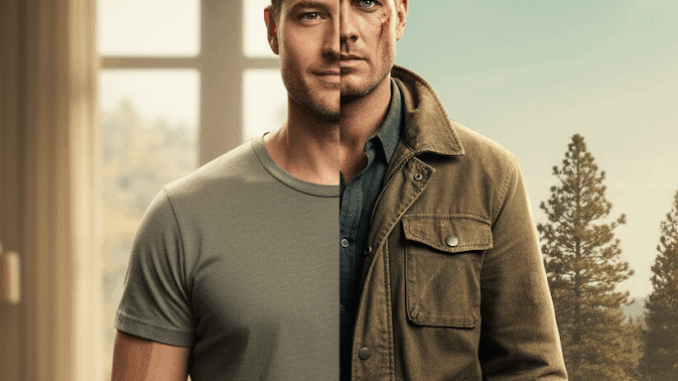
Justin Hartley has become synonymous with Colter Shaw, the resourceful and daring tracker at the heart of CBS’s hit series Tracker. Fans see the polished performance on screen, the intense action sequences, and the carefully measured emotional beats. What they don’t see is the meticulous preparation, behind-the-scenes dedication, and subtle craft that Hartley invests to bring this character to life. From stunts to psychology, his approach to acting on Tracker reveals a level of commitment that few viewers could imagine.
Hartley’s process begins long before the cameras roll. According to insiders, he spends hours studying Colter’s behaviors, motivations, and psychology, mapping out emotional arcs for each scene. “Justin treats Colter as a real person,” says a co-star. “He analyzes decisions, fears, and impulses in a way that’s incredibly detailed. It’s like method acting, but tailored for network television.” This preparation ensures that even during intense action or dialogue-heavy sequences, the performance remains grounded and believable.
Physical preparation is equally rigorous. Hartley reportedly undergoes weeks of stunt training before filming major sequences. Fight choreography, weapon handling, and tactical maneuvers are all practiced repeatedly to achieve both realism and safety. Crew members describe Hartley as relentless: practicing stunts multiple times, reviewing footage, and perfecting timing to make every move look effortless. “He doesn’t just perform stunts; he embodies them,” says a stunt coordinator.
Hartley also collaborates closely with directors and cinematographers to ensure that each scene maximizes narrative impact. He is said to provide input on camera angles, lighting, and pacing to enhance the storytelling, demonstrating an unusual level of creative involvement for a lead actor in a network procedural. “Justin thinks about the scene as a whole, not just his lines,” a director notes. “That attention to detail elevates the show.”
Character development goes beyond scripts. Insiders reveal that Hartley keeps a private journal of Colter’s backstory, emotional triggers, and potential choices that may not even appear on-screen. “It’s a map of the character’s mind,” explains a co-star. “Justin refers to it constantly, especially for emotionally intense or morally ambiguous scenes.” This commitment allows him to deliver a consistent, nuanced performance, even when scripts are adjusted mid-production.
The emotional aspect of acting in Tracker is particularly challenging. Hartley reportedly spends time visualizing scenarios, practicing improvisation, and rehearsing lines with fellow actors to maintain authenticity. For scenes that require subtle emotion—fear, hesitation, moral conflict—Hartley reportedly uses real-life experiences and empathy to deepen the portrayal. “It’s not about acting safe; it’s about feeling real,” a co-star explains.
Collaboration with other actors is another crucial part of Hartley’s process. When working with Jensen Ackles—or other recurring cast members—Hartley reportedly invests time in rehearsing chemistry, refining timing, and exploring dynamics that aren’t fully scripted. Even unscripted reactions are guided by prior understanding of characters’ personalities, creating moments that feel spontaneous but are rooted in preparation.
Hartley’s approach extends to technical mastery. He reportedly studies scene blocking meticulously, ensuring that movements, eye lines, and interactions with props or environment enhance narrative clarity. This technical skill allows Hartley to perform seamlessly in complex scenes, including chase sequences, confrontations, and high-tension investigations, all while maintaining character consistency.

Even wardrobe and makeup are considered part of the craft. Hartley reportedly discusses costume choices with designers, understanding how clothing can communicate Colter’s mindset, role, and narrative progression. “It’s subtle, but it matters,” a costume designer notes. “Justin knows how small details—like a jacket worn loosely or a scuff on a boot—tell a story.”
Hartley’s secret to sustaining performance intensity over long seasons is reportedly rooted in mental discipline. Meditation, visualization, and careful scheduling allow him to maintain focus, physical energy, and emotional availability during grueling shoots. Sources say that without this preparation, the consistency and nuance he brings to Colter Shaw would be impossible.
Finally, Hartley reportedly experiments with improvisation to inject realism into the show. Certain dialogue choices, gestures, or reactions are crafted spontaneously on set, enhancing authenticity. Directors describe these moments as “electric,” where Hartley’s instincts elevate scripted material into unforgettable scenes.
Ultimately, what makes Justin Hartley’s portrayal of Colter Shaw so compelling isn’t just natural charisma—it’s the invisible work that goes into each episode. Preparation, research, physical training, emotional investment, collaboration, and technical mastery all converge to create a performance that captivates viewers week after week. Fans may see only the final product on-screen, but the artistry behind it is immense, deliberate, and fascinating.
In essence, Tracker isn’t just a procedural thriller—it’s a showcase of Hartley’s craft. By blending psychology, physicality, and emotional depth, he transforms Colter Shaw from a scripted character into a living, breathing, unpredictable figure. It’s a reminder that great acting is never accidental, and behind every intense gaze, strategic move, and quiet reflection lies a dedication few fans will ever fully appreciate.
